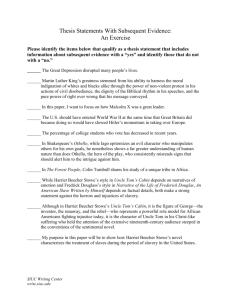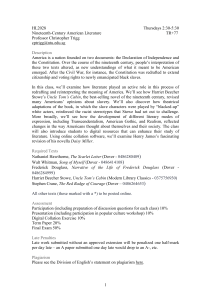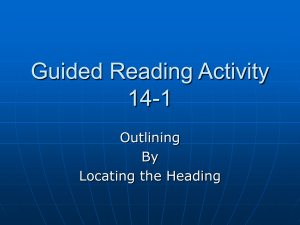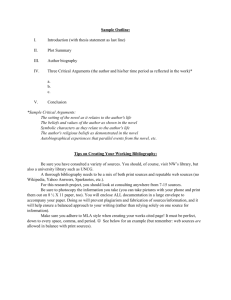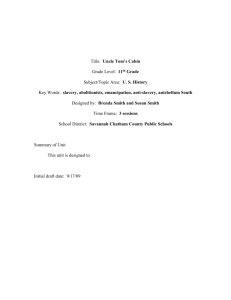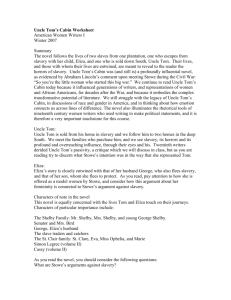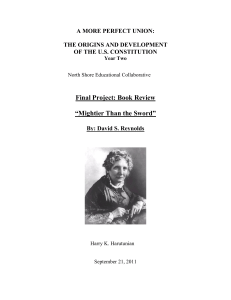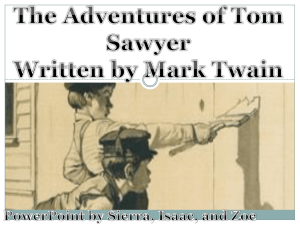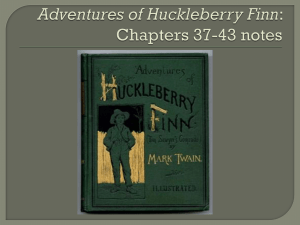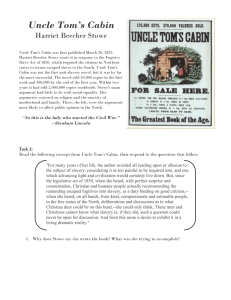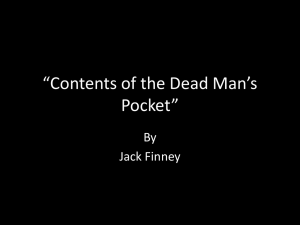Chapter 6 The Civil War (1861
advertisement
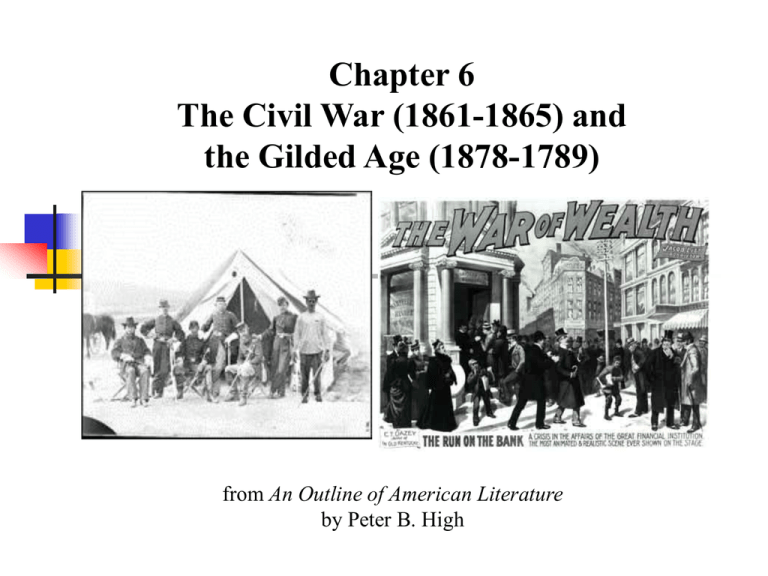
Chapter 6 The Civil War (1861-1865) and the Gilded Age (1878-1789) from An Outline of American Literature by Peter B. High Walt Whitman(18191892) Leaves of Grass wanted “to define America, her athletic democracy.” his poems contain lists of “sights and objects” any 19th century American could recognize his two favorite words are “sing” and “absorb” He “absorbs” the sights, sounds, smells and tastes of the world around him, and then “sings” them out in poetry. remained an incomplete “work in progress,” the book grew and changed as he and America grew and change Walt Whitman (1819-1892) First edition Leaves of Grass – describes Whitman’s non-systematic way of studying the world (p.70) “Song of Myself” he introduces himself as “Walt Whitman, a Cosmos” the “real self” includes everything in the universe Transcendentalist idea of “self,” “Nothing, not God, is greater than the self is” an expansion of Emerson’s idea of the “Over-Soul” Walt Whitman (1819-1892) Contributions – freed American poets from the old English tradition (p.73) “the time had come to reflect all themes and things, old and new, in the lights thrown on them by the advent of America and democracy.” – from A Backward Glance o’er Travel’d Roads Walt Whitman (1819-1892) the first one to explore the possibilities of free verse lines are not organized into stanza, look more like ordinary sentences, rarely uses rhyme or meter message was more important than form wrote in plain style so ordinary people could read his poetry Civil War Poems, “O Captain! My Captain!” “When Lilacs Last in the Dooryard Bloom’d” Harriet Beecher Stowe (1811-1896) Uncle Tom’s Cabin (1852) a masterpiece of Abolitionist propaganda (p.74) helped expand the campaign in the North against Southern slavery which led to the Civil War Lincoln made “Gettysburg Address of 1863” and gave this address on the field where the great battles of the Civil War had been fought Harriet Beecher Stowe The Beecher family were known as staunch abolitionists, and the movement heralded Harriet Beecher Stowe's novel Uncle Tom's Cabin. Both her father, Reverend Lyman Beecher, and her brother, Reverend Henry Ward Beecher, preached fiery anti-slavery sermons from their pulpits. Uncle Tom's Cabin On June 5, 1851, Uncle Tom's Cabin; or, Life Among the Lowly began to appear in serial form in the Washington National Era, an abolitionist weekly. Harriet Beecher Stowe's anti-slavery story was published in forty installments over the next ten months. For her story Mrs. Stowe was paid $300. Uncle Tom's Cabin Although the weekly had a limited circulation, its audience increased as reader after reader passed their copy along to another. In March 1852, a Boston publisher decided to issue Uncle Tom's Cabin as a book and it became an instant best seller. Three hundred thousand copies were sold the first year, and about 2,000,000 copies were sold worldwide by 1857. For one three month period Stowe reportedly received $10,000 in royalties. Across the nation people discussed the novel and hotly debated the most pressing socio-political issue dramatized in its narrative, slavery. From: http://memory.loc.gov/ammem/today/jun05.html Uncle Tom's Cabin Because Uncle Tom's Cabin so polarized the abolitionist and anti-abolitionist debate, some claim it to be one of the causes of the Civil War. Indeed, when President Lincoln received its author, Harriet Beecher Stowe, at the White House in 1862, legend has it he exclaimed, "So this is the little lady who made this big war?" Poster publicizing Harmount's production of "Uncle Tom's Cabin" at the Wilmington, Ohio Opera House on Monday, September 27 (year unknown). Harmount's Uncle Tom's Cabin Company was a theatrical road show company which operated from 19031929, and was based in Williamsport, Ohio Main Characters in Uncle Tom’s Cabin (Theatrical Posters) Eliza George Peck's Grand Revival of Stetson's Uncle Tom's Cabin Booked by Klaw & Erlanger, Legree Topsy Emily Dickinson (1830-1886) Amherst, Massachusetts, Calvinist childhood (p.77) early in life she rejected her family’s old-fashioned religion and made the search for faith her guide is Ralph Waldo Emerson think of “faith” as a temporary “prop” for the soul “we can cling to nothing” images and themes taken from Emerson’s essay poems in the early 1860s, pain and limitation became new themes and her way to express the terrible suffering of the Civil War Other Writers Sarah Orne Jewett (1849-1990) – p.77 “A White Heron” (1886), The Country of the Pointed Firs (1896) George Washington Cable (1844-1925) Specialized in the life of the Creoles (French whites living in the New Orleans region) Joel Chandler Harris (1849-1908) he was a white southerner, and popularized Negro folklore Uncle Remus tales Bret Harte (1836-1902) moved to California during the ”Gold Rush” days of the 1850s (p.78) The Luck of Roaring Camp (1868), Outcasts of Poker Flat (1869) Provided the model for all the “Westerners” William Dean Howells remarked that American West could be described “without the sense of any older civilization outside of it.” Because of this freedom, the writer of the West were able to create the first “all-American” literature Mark Twain (1835-1910) from 1857-61 Twain worked as a river pilot, Life on the Mississippi (1883) based on this romantic memories (p.80) became nationally famous for his short story The Celebrated Jumping Frog stories about how ordinary people trick experts, how the weak succeed in “hoxing” the strong filled with a typical Western humor story called a “hoax” Mark Twain (1835-1910) Twain in 1867 went to Europe and the Holy Land, Innocents Abroad (1869) showed his hatred of the European aristocracy critical of American tourists in Europe A Tramp Abroad Roughing It (1872) about his travels in the Far West Mark Twain (1835-1910) The Gilded Age (1870) co-written with Charles Warner, described the new morality/immorality of postCivil War America created a picture of the entire nation not just one region the real theme is America’s loss of its old idealism young people are morally destroyed by the dream of becoming rich Writer and humorist, Mark Twain, wrote the novel The Gilded Age ridiculing Washington D.C. and many of the leading figures of the day The Gilded Age By 1870, not only the role of women was being challenged. Industrialists, corporations, utilities, bankers, and brokers were increasingly viewed as an enemy by the working class, whose wages had stagnated while men who were already millionaires got richer. Failed land deals, speculation, and corruption were prevalent. Many workers went from being independent tradesmen to being wage laborers concentrated in large factories. Millions of immigrants swelled the population of U.S. cities and began to compete for jobs. Labor unions were born to represent these angry and beleaguered workers. Mark Twain and Charles Dudley Warner captured some of this turmoil in a book on which they collaborated, The Gilded Age, a tale of corruption and failed land deals and a loss of innocence. The book's title was often used to describe this period. Mark Twain (1835-1910) Adventures of Tom Sawyer (1876), a story about bad boys (p.81) A popular theme in American Lit. two young heroes, Tom and Huck Finn, are bad boys Tom is very romantic; his view of life comes from books about knights in the Middle Ages Huck is a real outsider who never sees the world in the romantic way Tom Sawyer Mark Twain (1835-1910) gives his young hero, Huck, an adult problem (p.83) a great novel of American democracy shows the basic goodness and wisdom of ordinary people “the school of many late Western writers” Sherwood Anderson used it as a model for his Winesburg, Ohio (1919) Ernest Hemingway claimed, “All modern American literature comes from Huckleberry Finn.” Huckleberry Finn Huck and Jim When we first see him, Nigger Jim, for all his freedom, comes off as little more than a "blackface" clown, the common racial stereotype of that long-ago America. He is as one-dimensional as Friday. But the secret of Huckleberry Finn is that young Huck lives with and learns from Jim and gradually discovers what Humanity is about, as Huck growls, "All right, then, I'll go to hell" and decides to "steal him [Jim] out of slavery." From http://www.brightlightsfilm.com/30/crusoe4.html Mark Twain (1835-1910) Twin’s later novels seemed less hopeful about democracy and pessimistic about the goodness of human nature A Connecticut Yankee in King Arthur’s Court (1889) The Man That Corrupted Hadleyburg (1900) The $30,000 Request (1904) The Mysterious Stranger (1916) shows the conflict between the ideals of Americans and their desire for money
